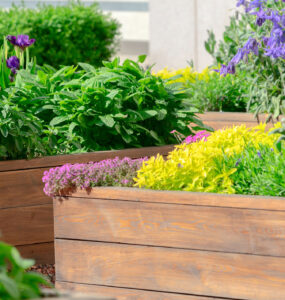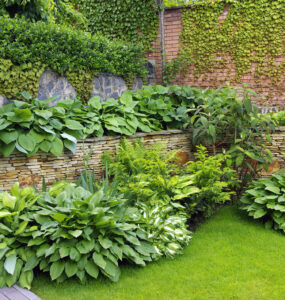Container Gardening Secrets
by Rob Sproule
Gorgeous containers aren’t just found in glossy magazines and Martha Stewart specials. They’re within our grasp no matter how black our thumbs may be, and I have a few secrets to help you along.
Here are 3 things I’ve learned from my years in the gardening trenches. You don’t often read about these tips, but they’re essential in my book. 2 of them are about maintaining healthy roots, which are the key to good plants, and the last one is about creating a great design.
Choose your Container Wisely
Container gardens are like icebergs. We Ooh and Ah at what we see, but it’s the complex structures below the surface that keeps the whole thing afloat.
Savvy gardeners know that terrific containers are all about moisture and heat management at the root level. The type of pot you use, which is the material in direct contact with the roots, is often an afterthought but can be pivotal to how your flowers perform.
For starters, I’d avoid terra-cotta or clay unless you have a shady, humid spot. While amazing in England, our air is so dry that the porous material will act as a wick and suck the moisture right out of the roots, leaving your poor pansies parched.
When it comes to plastic or glazed ceramic, consider the pot’s colour. Reserve dark colours, which get exceptionally hot in direct sun, for heat lovers like peppers and gazania.
Synthetic pots, usually made of lightweight, high-end fiberglass and resin, are the best for the root systems but, with their steep price tags, the worst for your wallet. Keep an eye on them though, as they grow the best performing plants and are consistently coming down in price.
Mulch
Heat loving annuals and edibles, like petunias and tomatoes, are thirstier than Bavarians at Oktoberfest. Containers are enclosed systems, and big, aggressive plants often become root-bound by mid-summer, every drop of water being greedily sucked up by parched moisture lovers.
The stress that repeatedly drying out causes tropical species (which comprise the majority of trending annuals and edibles), can quickly lead to a lackluster look. Savvy gardeners are saving from twice a day watering by harnessing the moisture-retaining advantages of mulch.
Once reserved only for perennial beds and strawberry fields, organics mulch like cedar and straw help keep the soil moist by decreasing evaporation into our dry, hot summer air. More consistently moist soil, which is what tropical species love, will result in better summer performance and a less exhausting watering schedule.
Make sure to stick to untreated, organic mulches (ie. were only alive), and avoid treated inorganics like rock and rubber, which can dry the soil by heating in the sun and/or leech nasty chemicals down to the roots. A couple inches of mulch is all you need.
Planning
Unless you’re a design veteran, don’t go into your container planting blind. By laying out your plants before-hand you’ll be able to pre-plan the look you’re going for and get the most out of your design. Later on you can always claim to have improvised!
You can either go to the Garden Centre armed with a recipe plan-o-gram or do what I love doing: select the plants you fall in love with but arrange them on your cart as go. This way, you get the flowers you want while still pre-planning your pots.
Before you plant, take the time to set your potted plants into the container. Stand back and picture not only what it looks like now and, more importantly, what it will look like in 1 and 3 months. Ask yourself if you have very aggressive plants paired with passive plants (not a happy-ending for the slow growing marigolds), and if your tall, trailing, and mounding elements are in the best spot.
Make sure to take all the pots in each area of the yard into account. You don’t need to match them all, but tricks like putting one identical plant in each (no matter how big) will weave the entire scene together and make you look like a designing pro.
















